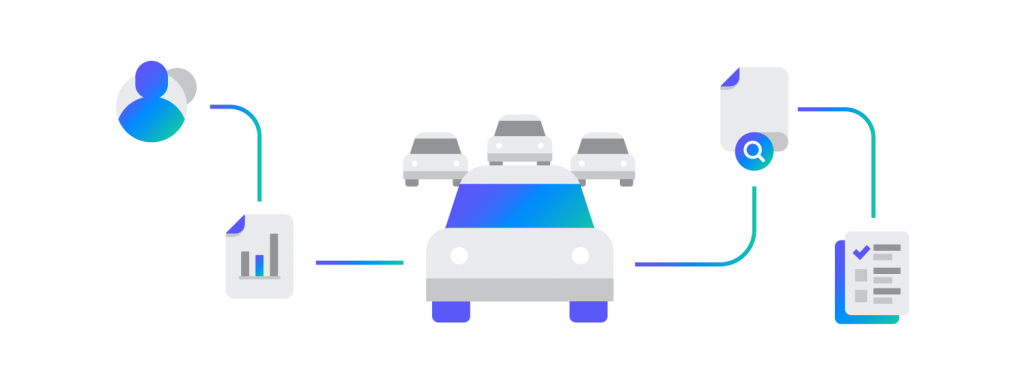Dealer car audits are necessary for lenders and car dealers. There’s just one problem. The traditional way of running dealer audits is inefficient and expensive.
Why “Send the auditors to the dealer” model needs updating
The traditional approach to auto dealer audits is dated and has not leveraged advances in technology. Letting outside staff go through your entire inventory has the potential to disrupt your operations. For example, what if the audit occurs as dealer employees are working on closing several sales? The presence of a dealer audit may distract customers from buying or accepting the offer of a test drive.
Yet, the need for lenders to verify assets is not going away. Fortunately, there is a new best practice: dealer self-audit. This is a win for both auto dealers and lenders.
How the dealer self-audit model helps dealers and lenders
For auto dealers, a self-managed dealer audit means time savings and fewer lost customers. A dealer can choose a convenient time during the day to carry out an audit so that sales and customer service with car buyers are never disrupted. Finally, dealers can also reduce the number of outside visitors to their facility. That’s a key concern given the lingering COVID-19 pandemic.
At first glance, lenders might not see the value in reducing or eliminating the practice of sending auditors to their dealers. In reality, there are multiple reasons why lenders can benefit from adopting dealer-self auditing. First, a dealer self-audit immediately improves the dealer experience and makes it less likely that you will lose the dealer to a competitor. Second, the dealer self-audit costs 50-75% less than the cost of carrying out a traditional in-person physical audit. Third, a dealer self-audit with the right mobile technology offers superior anti-fraud controls (e.g., user authentication, automatically time stamping photos, GPS location, and other metrics to ensure data integrity). Fourth, a dealer self-audit enables increased audit frequency to more effectively manage risk while providing real-time data and full transparency for both dealers and lenders. Finally, a modern dealer self-audit utilizing innovative new technology is faster because it automates clearing audits and reduces the time and effort hunting down vehicles missed in the initial audit due to test drives, repairs, and other circumstances.
How Kinetic Advantage is implementing dealer self-audit
To illustrate how a dealer self-audit approach can work, we asked Kinetic Advantage, a leading floorplan financing company, for their perspective. They are one of the early adopters of dealer self-auditing and shared the following comment.
“We are passionate about dramatically improving the dealer experience while maintaining the quality of our audit data by using 12th Tech’s Real-Time Intelligent Auditing System,” said Joe Keadle, Senior Vice President of Corporate Operations at Kinetic Advantage.
“Our audit partnership provides mobile tools and capabilities specifically designed to provide an exceptional and painless experience for dealers. We understand the historical difficulties of traditional inventory auto auditing and by leveraging technology we can maintain our internal data needs while eliminating the dealer’s typical upfront audit fee.”
How to get started with dealer self-audit
There are a few different ways to get started with dealer self-audit: the full implementation and the hybrid approach. The full implementation means switching from traditional physical dealer auditing to a self-audit-centric process with physical audit sampling. The hybrid approach involves phasing in a combination of traditional dealer audits with self-audits. Innovative real-time auditing systems are making it possible to seamlessly conduct a mix of traditional physical and dealer self-audits with full visibility of results available immediately to both lenders and dealers.
Use a risk-based approach to guide your approach to auditing dealers. With low-risk dealers, you might switch to quarterly auditing with three self-audits and one traditional audit per year. Consider passing your cost savings to the dealer to show your appreciation. The opposite is also true. With higher-risk borrowers, consider planning more frequent traditional audits (i.e., monthly in-person audits). If the borrower’s risk profile improves, you can switch to 50% self-audit and 50% in-person audits. By offering dealer self-audits, lenders can offer a better dealer experience which ultimately boosts dealer loyalty.
Choosing a next-generation floorplan finance platform like Solifi Wholesale Finance Software (previously known as CALMS Compass) makes adopting dealer self-audit easier because it works with various audit companies so you can offer a compelling dealer audience while managing risk. Whether you use Solifi Floorplan or something else, ask yourself if your platform is up to the challenge of offering self-auditing.
